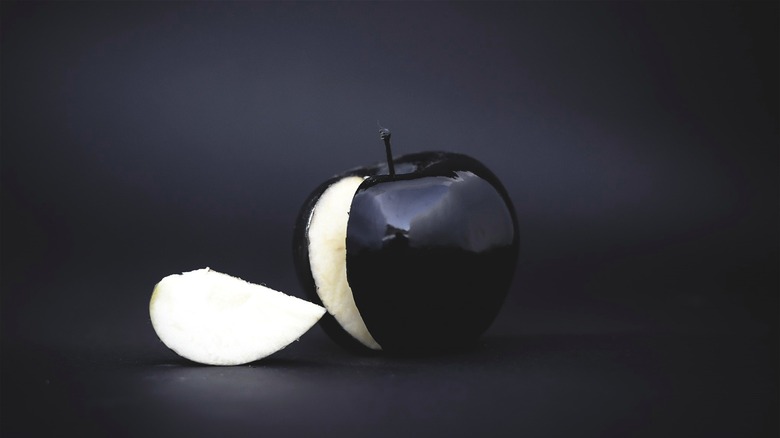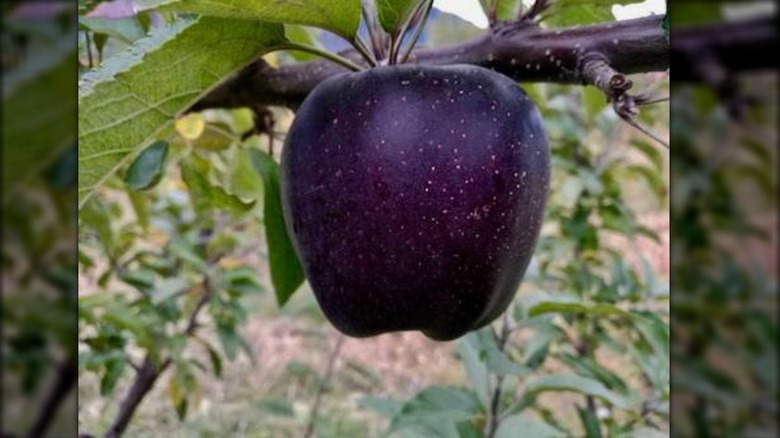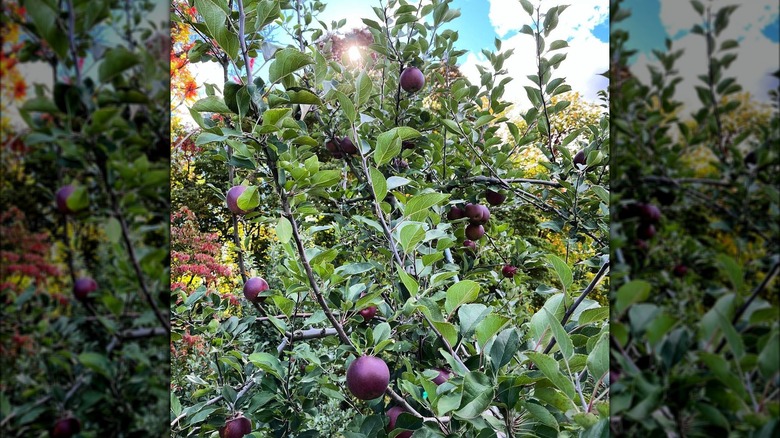What's So Special About 'Black Diamond' Apples?
Those of us who enjoy more than one serving of fresh fruit per day most likely have a small stash of apples stored away in our crisper drawers waiting to be consumed amidst a busy week. Unlike fresh berries, which only last two to seven days when properly stored (per Driscoll's), apples can last three weeks in the pantry and up to six weeks in the refrigerator (per Healthline).
Apart from their extended shelf life, apples have plenty of health benefits as well. The Harvard T.H. Chan School of Public Health explains that apples not only contain a high vitamin C count, but they're also a great source of fiber and have been found to potentially reduce or prevent health complications relating to cardiovascular disease and certain cancers. With so many benefits, it's no wonder apples are extremely popular. According to Statista, next to bananas and watermelons, apples ranked number three in global fruit production in 2020.
According to the University of Illinois Extension, there are more than 7,000 apple varieties grown worldwide. The most sought-after types in America include fuji, gala, honeycrisp, and red delicious (per USApple.org). But there's one apple variety that's been growing in Asia for years and has recently garnered quite a bit of attention for its elusive characteristics.
The unique qualities of black diamond apples
Black diamond apples are fairly mysterious; even the best apple orchards in America can't grow the variety. According to Today, black diamond apples stem from the Chinese red delicious family or Huaniu family and are specifically grown in Tibet, an east Asian region governed by China (per Britannica). The reason this mystical variety grows only in this specific region has everything to do with the environment and unusual weather patterns of the far-off location.
Black diamond apples have become a popular conversation starter because of their rare dark purple skin, which Mental Floss says is created only through the varying temperature changes found in the Nyingchi mountains. During the day, the growing fruit is exposed to constant sunlight at higher-than-average altitudes only to endure cold temperatures in the evening hours. Britannica goes more in-depth on the rare climate of Tibet, showcasing how the largest temperature changes occur within 24-hour periods; temperatures can range from 85 F during the day to as low as -2 F at night.
Black diamond apples take eight years after planting to bear fruit; their rare color and finicky growing conditions also make them more expensive. In Asian supermarkets, black diamond apples are often sold for $7 apiece. But if you're after a richly hued apple, don't lose hope yet — surprisingly, you have a few varieties to choose from in the states.
Dark apples are also available in America
Mental Floss describes black diamond apple's exclusivity, with its extra sweet-bite and dark purple color. But you can still try your hand at securing the next-best thing in the United States. There are a few varieties that, once picked, get sweeter the longer they sit in cold storage.
Minnetonka Orchards explains that black Oxford apples, which are grown in Maine, are slowly becoming just as popular as honeycrisp due to their extreme hardiness, uniquely colored skin, and sweetly spiced flesh. They are mainly sold in the northeast and store particularly well due to their accustomed cold-weather growing conditions.
If you're not anywhere close to Maine, you can try your luck at securing Arkansas black apples, which are primarily grown in Benton County Arkansas (per Atlas Obscura). What sets Arkansas black apples apart from other dark varieties is the suggested time of consumption. Specialty Produce explains that this rare variety is typically picked and kept in cold storage to increase sweetness. Atlas Obscura states that after sitting in storage for at least one month, you'll be able to enjoy this assortment's unique flavor notes of coriander, cherry, and vanilla. Whether you use these deeply vibrant apples to make a raw apple crisp recipe or enjoy them freshly sliced, they're sure to offer a new and much-welcomed flavor experience.


